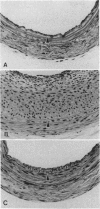Abstract
Carvedilol is a cardiovascular drug currently used for the treatment of hypertension. Clinical studies have recently demonstrated efficacy in angina and congestive heart failure. Recently, carvedilol has been shown to attenuate oxygen free radical-initiated lipid peroxidation and to inhibit vascular smooth muscle mitogenesis induced by a wide variety of growth factors. These findings are of interest since smooth muscle proliferation and abnormal lipid metabolism are proposed to play an important role in the pathogenesis of atherosclerotic plaque formation and in development of stenotic lesions following vascular injury by balloon angioplasty and coronary artery bypass grafting. On the basis of these observations, the antiproliferative actions of carvedilol have been explored in detail. In human cultured pulmonary artery vascular smooth muscle cells, carvedilol (0.1-10 microM) produced a concentration-dependent inhibition of the mitogenesis stimulated by platelet-derived growth factor, epidermal growth factor, thrombin, and serum, with IC50 values ranging from 0.3 to 2.0 microM. Carvedilol also produced a concentration-dependent inhibition of vascular smooth muscle cell migration induced by platelet-derived growth factor, with an IC50 value of 3 microM. The extensive neointimal formation that occurs following balloon angioplasty of rat carotid arteries was markedly attenuated by carvedilol (1 mg/kg, i.p.; twice daily starting 3 days before angioplasty and continuing until 14 days after angioplasty). Quantitative image analysis demonstrated that carvedilol reduced the neointimal growth following angioplasty by 84% without altering either medial or adventitial cross-sectional areas. These observations indicate that carvedilol may also be effective in the treatment of pathological disorders principally associated with abnormal vascular smooth muscle growth, such as atherosclerosis and acute vascular wall injury induced by angioplasty or coronary artery bypass grafting.
Full text
PDF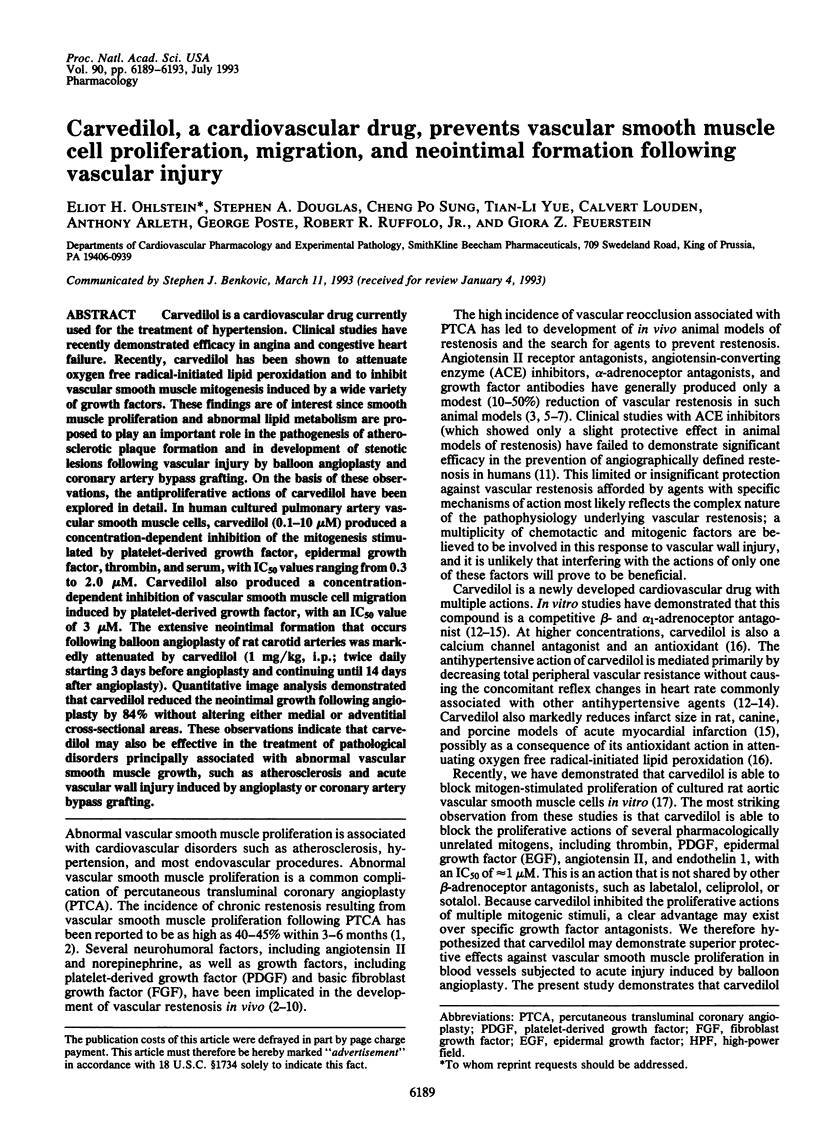
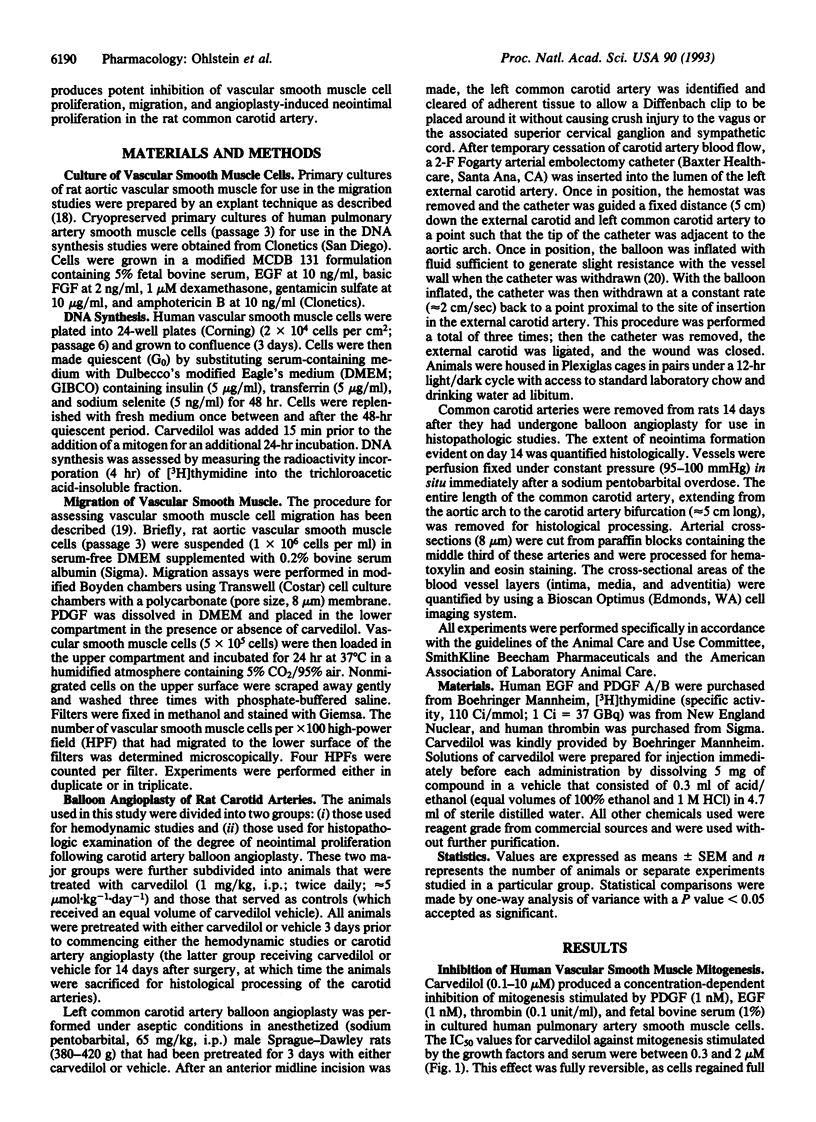
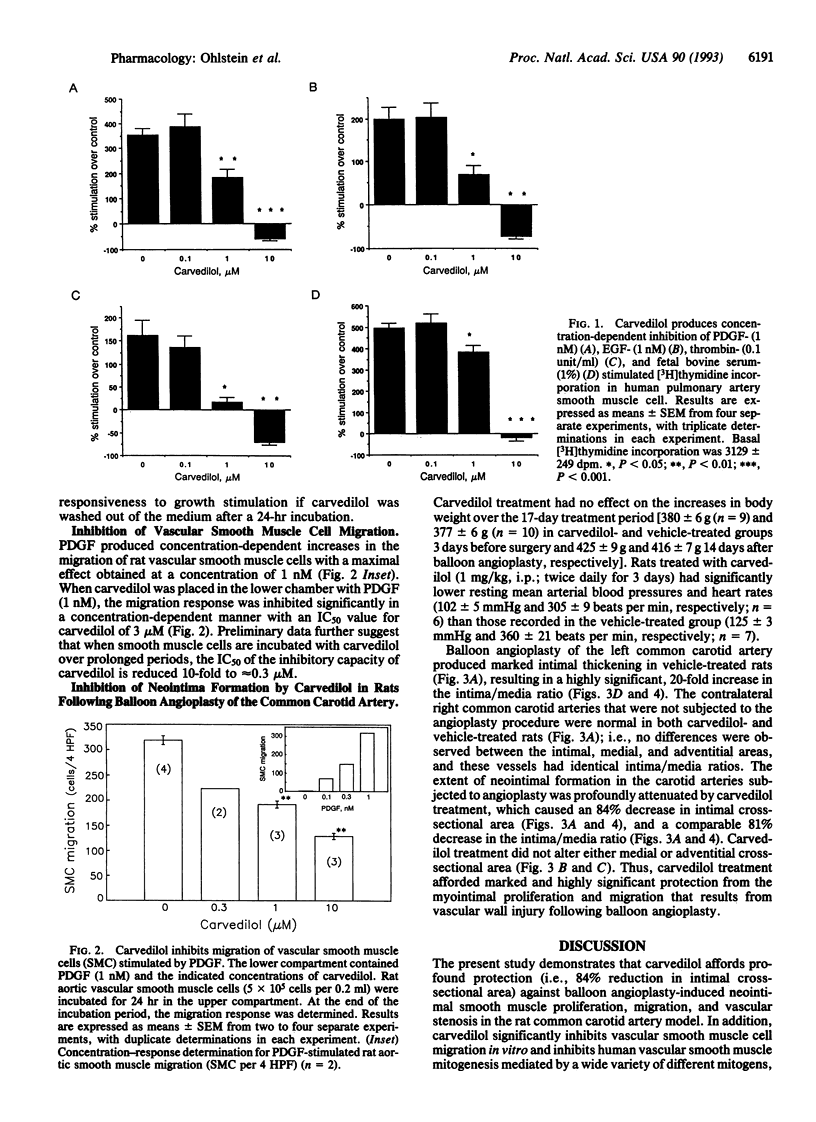
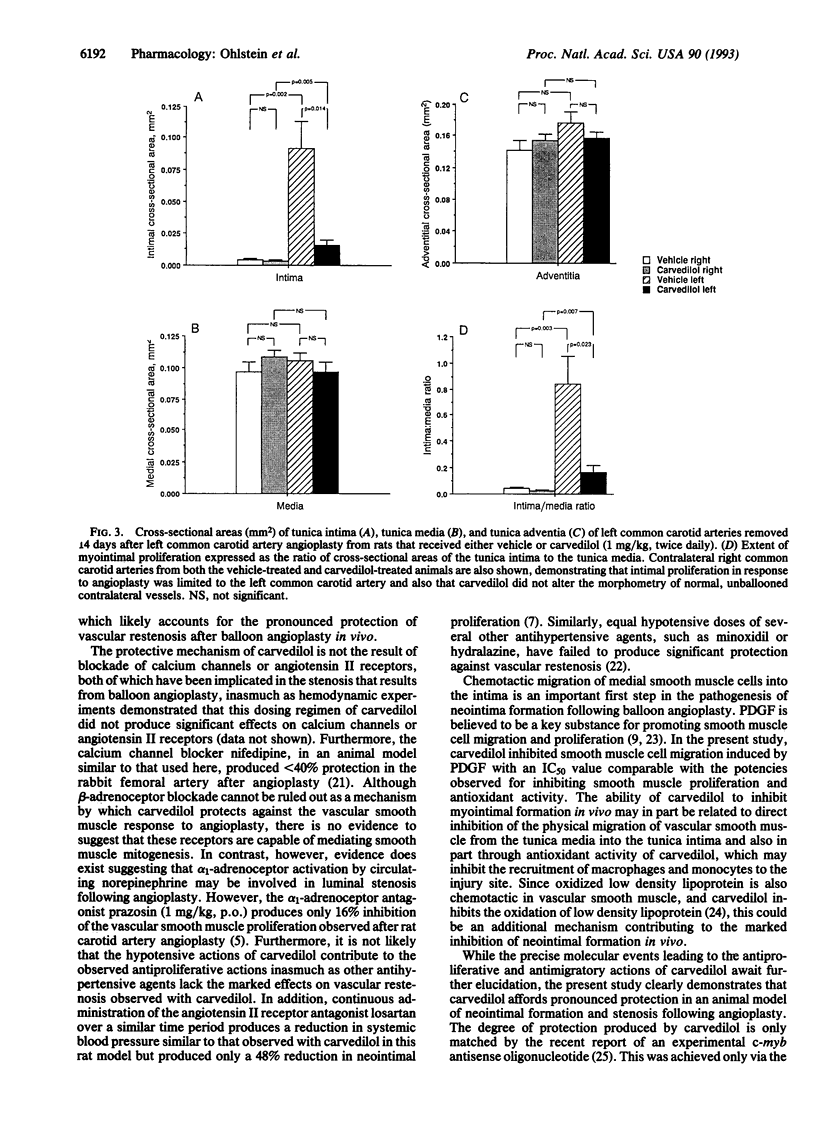
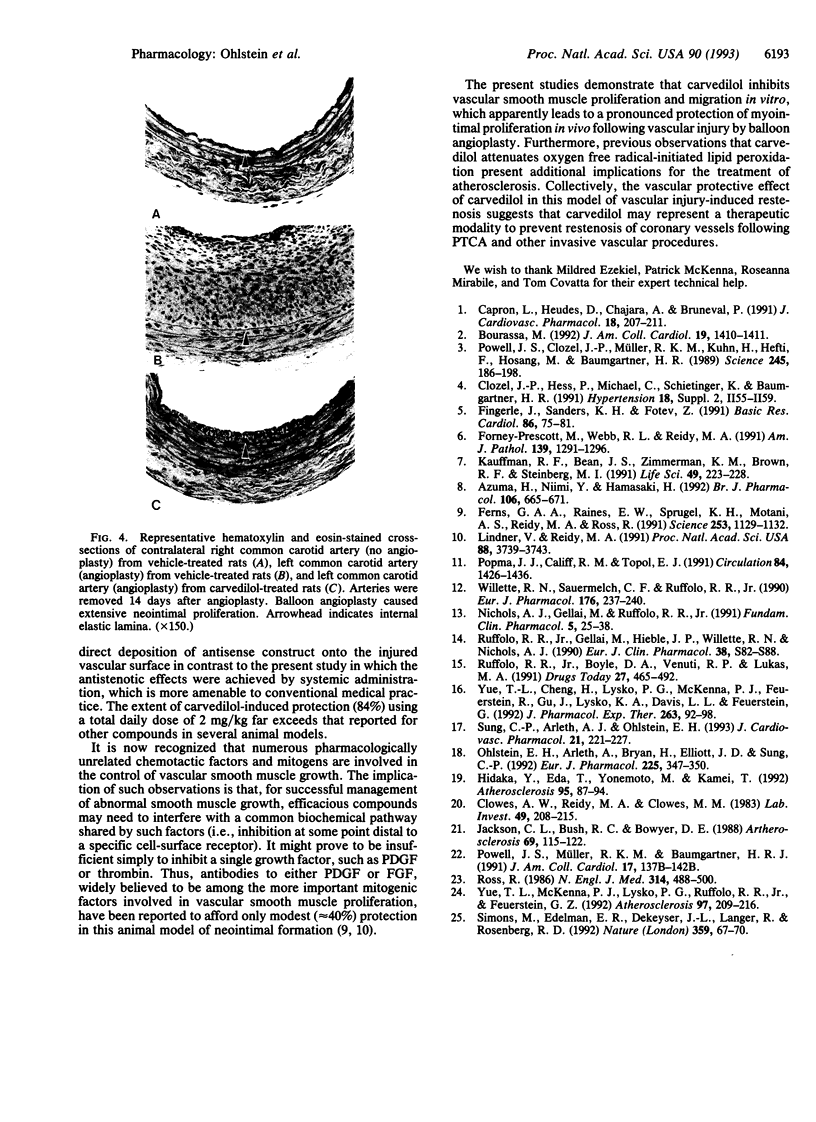
Images in this article
Selected References
These references are in PubMed. This may not be the complete list of references from this article.
- Azuma H., Niimi Y., Hamasaki H. Prevention of intimal thickening after endothelial removal by a nonpeptide angiotensin II receptor antagonist, losartan. Br J Pharmacol. 1992 Jul;106(3):665–671. doi: 10.1111/j.1476-5381.1992.tb14392.x. [DOI] [PMC free article] [PubMed] [Google Scholar]
- Bourassa M. G. Silent myocardial ischemia after coronary angioplasty: distinguishing the shadow from the substance. J Am Coll Cardiol. 1992 Jun;19(7):1410–1411. doi: 10.1016/0735-1097(92)90595-e. [DOI] [PubMed] [Google Scholar]
- Capron L., Heudes D., Chajara A., Bruneval P. Effect of ramipril, an inhibitor of angiotensin converting enzyme, on the response of rat thoracic aorta to injury with a balloon catheter. J Cardiovasc Pharmacol. 1991 Aug;18(2):207–211. doi: 10.1097/00005344-199108000-00005. [DOI] [PubMed] [Google Scholar]
- Clowes A. W., Reidy M. A., Clowes M. M. Mechanisms of stenosis after arterial injury. Lab Invest. 1983 Aug;49(2):208–215. [PubMed] [Google Scholar]
- Clozel J. P., Hess P., Michael C., Schietinger K., Baumgartner H. R. Inhibition of converting enzyme and neointima formation after vascular injury in rabbits and guinea pigs. Hypertension. 1991 Oct;18(4 Suppl):II55–II59. doi: 10.1161/01.hyp.18.4_suppl.ii55. [DOI] [PubMed] [Google Scholar]
- Ferns G. A., Raines E. W., Sprugel K. H., Motani A. S., Reidy M. A., Ross R. Inhibition of neointimal smooth muscle accumulation after angioplasty by an antibody to PDGF. Science. 1991 Sep 6;253(5024):1129–1132. doi: 10.1126/science.1653454. [DOI] [PubMed] [Google Scholar]
- Fingerle J., Sanders K. H., Fotev Z. Alpha 1-receptor antagonists urapidil and prazosin inhibit neointima formation in rat carotid artery induced by balloon catheter injury. Basic Res Cardiol. 1991;86 (Suppl 1):75–81. [PubMed] [Google Scholar]
- Hidaka Y., Eda T., Yonemoto M., Kamei T. Inhibition of cultured vascular smooth muscle cell migration by simvastatin (MK-733). Atherosclerosis. 1992 Jul;95(1):87–94. doi: 10.1016/0021-9150(92)90179-k. [DOI] [PubMed] [Google Scholar]
- Jackson C. L., Bush R. C., Bowyer D. E. Inhibitory effect of calcium antagonists on balloon catheter-induced arterial smooth muscle cell proliferation and lesion size. Atherosclerosis. 1988 Feb;69(2-3):115–122. doi: 10.1016/0021-9150(88)90004-4. [DOI] [PubMed] [Google Scholar]
- Lindner V., Reidy M. A. Proliferation of smooth muscle cells after vascular injury is inhibited by an antibody against basic fibroblast growth factor. Proc Natl Acad Sci U S A. 1991 May 1;88(9):3739–3743. doi: 10.1073/pnas.88.9.3739. [DOI] [PMC free article] [PubMed] [Google Scholar]
- Nichols A. J., Gellai M., Ruffolo R. R., Jr Studies on the mechanism of arterial vasodilation produced by the novel antihypertensive agent, carvedilol. Fundam Clin Pharmacol. 1991;5(1):25–38. doi: 10.1111/j.1472-8206.1991.tb00698.x. [DOI] [PubMed] [Google Scholar]
- Ohlstein E. H., Arleth A., Bryan H., Elliott J. D., Sung C. P. The selective endothelin ETA receptor antagonist BQ123 antagonizes endothelin-1-mediated mitogenesis. Eur J Pharmacol. 1992 Apr 10;225(4):347–350. doi: 10.1016/0922-4106(92)90109-9. [DOI] [PubMed] [Google Scholar]
- Popma J. J., Califf R. M., Topol E. J. Clinical trials of restenosis after coronary angioplasty. Circulation. 1991 Sep;84(3):1426–1436. doi: 10.1161/01.cir.84.3.1426. [DOI] [PubMed] [Google Scholar]
- Powell J. S., Clozel J. P., Müller R. K., Kuhn H., Hefti F., Hosang M., Baumgartner H. R. Inhibitors of angiotensin-converting enzyme prevent myointimal proliferation after vascular injury. Science. 1989 Jul 14;245(4914):186–188. doi: 10.1126/science.2526370. [DOI] [PubMed] [Google Scholar]
- Powell J. S., Muller R. K., Baumgartner H. R. Suppression of the vascular response to injury: the role of angiotensin-converting enzyme inhibitors. J Am Coll Cardiol. 1991 May;17(6 Suppl B):137B–142B. doi: 10.1016/0735-1097(91)90950-e. [DOI] [PubMed] [Google Scholar]
- Prescott M. F., Webb R. L., Reidy M. A. Angiotensin-converting enzyme inhibitor versus angiotensin II, AT1 receptor antagonist. Effects on smooth muscle cell migration and proliferation after balloon catheter injury. Am J Pathol. 1991 Dec;139(6):1291–1296. [PMC free article] [PubMed] [Google Scholar]
- Ross R. The pathogenesis of atherosclerosis--an update. N Engl J Med. 1986 Feb 20;314(8):488–500. doi: 10.1056/NEJM198602203140806. [DOI] [PubMed] [Google Scholar]
- Ruffolo R. R., Jr, Gellai M., Hieble J. P., Willette R. N., Nichols A. J. The pharmacology of carvedilol. Eur J Clin Pharmacol. 1990;38 (Suppl 2):S82–S88. doi: 10.1007/BF01409471. [DOI] [PubMed] [Google Scholar]
- Simons M., Edelman E. R., DeKeyser J. L., Langer R., Rosenberg R. D. Antisense c-myb oligonucleotides inhibit intimal arterial smooth muscle cell accumulation in vivo. Nature. 1992 Sep 3;359(6390):67–70. doi: 10.1038/359067a0. [DOI] [PubMed] [Google Scholar]
- Sung C. P., Arleth A. J., Ohlstein E. H. Carvedilol inhibits vascular smooth muscle cell proliferation. J Cardiovasc Pharmacol. 1993 Feb;21(2):221–227. doi: 10.1097/00005344-199302000-00006. [DOI] [PubMed] [Google Scholar]
- Willette R. N., Sauermelch C. F., Ruffolo R. R., Jr Local cutaneous hemodynamic effects of carvedilol and labetalol in the anesthetized rat. Eur J Pharmacol. 1990 Feb 6;176(2):237–240. doi: 10.1016/0014-2999(90)90535-e. [DOI] [PubMed] [Google Scholar]
- Yue T. L., Cheng H. Y., Lysko P. G., McKenna P. J., Feuerstein R., Gu J. L., Lysko K. A., Davis L. L., Feuerstein G. Carvedilol, a new vasodilator and beta adrenoceptor antagonist, is an antioxidant and free radical scavenger. J Pharmacol Exp Ther. 1992 Oct;263(1):92–98. [PubMed] [Google Scholar]
- Yue T. L., McKenna P. J., Lysko P. G., Ruffolo R. R., Jr, Feuerstein G. Z. Carvedilol, a new antihypertensive, prevents oxidation of human low density lipoprotein by macrophages and copper. Atherosclerosis. 1992 Dec;97(2-3):209–216. doi: 10.1016/0021-9150(92)90133-2. [DOI] [PubMed] [Google Scholar]




